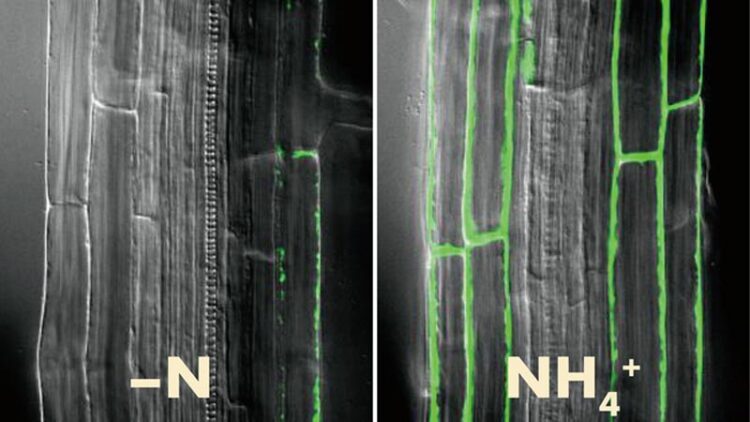Rooting out how plants control nitrogen use

A diagram explaining the mechanism at work when plants utilize nitrogenous fertilizers.
Credit: Tohoku University
Insights into gene and protein control systems that regulate the use of nitrogen by plant roots could help develop crops that require less nitrogenous fertilizers to produce acceptable yields. Plant biochemist Soichi Kojima and colleagues at Tohoku University discuss their findings and future plans in an article in the journal Frontiers in Plant Science.
Nitrogen is such a crucial nutrient for plants that vast quantities of nitrogen-containing fertilizers are spread on farmlands worldwide. These fertilizers mostly contain nitrogen as ammonium ions (NH4 +), the chemical form in which nitrogen is most readily taken up by plant roots. However, excess nitrogen in the soil and in drainage run-off into lakes and rivers causes serious ecological imbalances, including algal blooms that de-oxygenate water and kill fish and other aquatic life.
“One of the key goals of modern agricultural research is to develop crops that can grow healthily without relying on so much added nitrogen,” says Kojima. He adds that there are also significant economic and environmental incentives behind this aim, pointing out: “Energy from vast quantities of fossil fuels is currently needed to convert nitrogen in the air into ammonium for fertilizers.”
The researchers worked with the small flowering plant thale cress (Arabidopsis thaliana), a common species used for laboratory studies in plant science.
“Taken together, our results reveal, at the genetic level, regulatory mechanisms at work when plants utilize nitrogenous fertilizers in their roots,” says Kojima.
The team’s next step is to determine if the processes they have identified in Arabidopsis are shared by other plant species, especially major crop plants such as rice and other cereals. If that is confirmed it could open an avenue for plant breeders and geneticists to generate crops that might need much less fertilizer while still producing the yields needed to feed the world. Enhancing the production or activity of the amino acid-making enzymes could be the key to success.
Journal: Frontiers in Plant Science
DOI: 10.3389/fpls.2023.1127006
Article Title: Coregulation of glutamine synthetase1;2 (GLN1;2) and NADH-dependent glutamate synthase (GLT1) gene expression in Arabidopsis roots in response to ammonium supply
Article Publication Date: 20-Feb-2023
Media Contact
Public Relations
Tohoku University
public_relations@grp.tohoku.ac.jp
All latest news from the category: Life Sciences and Chemistry
Articles and reports from the Life Sciences and chemistry area deal with applied and basic research into modern biology, chemistry and human medicine.
Valuable information can be found on a range of life sciences fields including bacteriology, biochemistry, bionics, bioinformatics, biophysics, biotechnology, genetics, geobotany, human biology, marine biology, microbiology, molecular biology, cellular biology, zoology, bioinorganic chemistry, microchemistry and environmental chemistry.
Newest articles

First-of-its-kind study uses remote sensing to monitor plastic debris in rivers and lakes
Remote sensing creates a cost-effective solution to monitoring plastic pollution. A first-of-its-kind study from researchers at the University of Minnesota Twin Cities shows how remote sensing can help monitor and…

Laser-based artificial neuron mimics nerve cell functions at lightning speed
With a processing speed a billion times faster than nature, chip-based laser neuron could help advance AI tasks such as pattern recognition and sequence prediction. Researchers have developed a laser-based…

Optimising the processing of plastic waste
Just one look in the yellow bin reveals a colourful jumble of different types of plastic. However, the purer and more uniform plastic waste is, the easier it is to…



